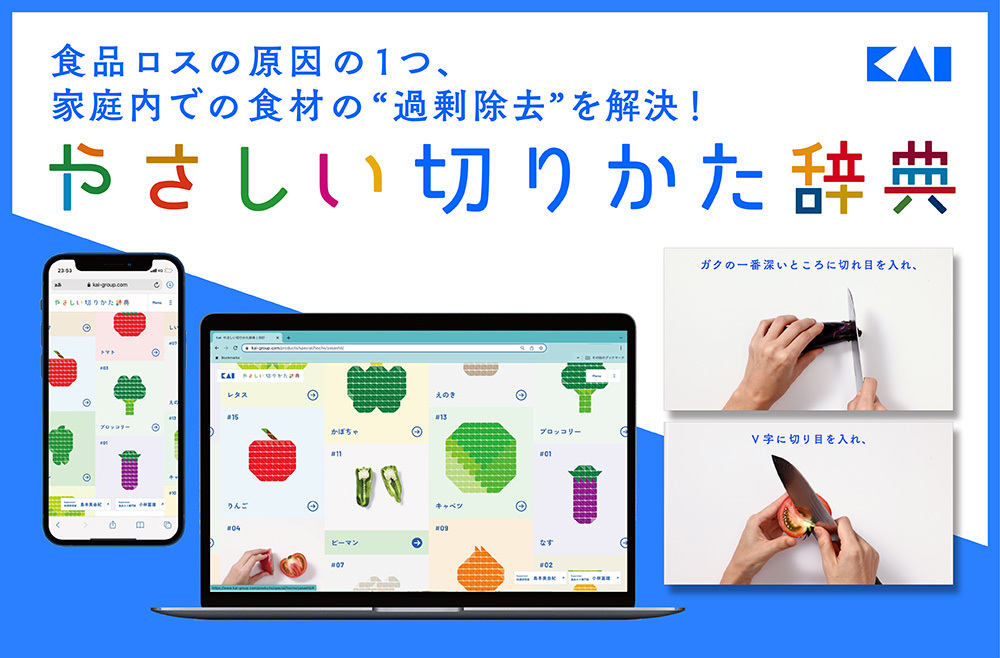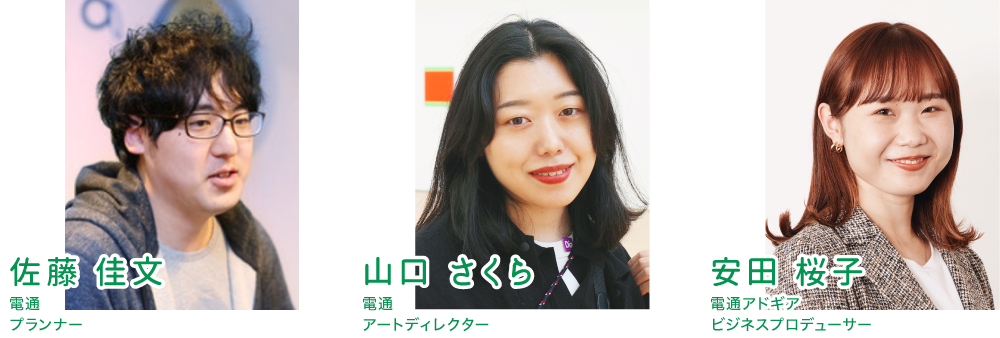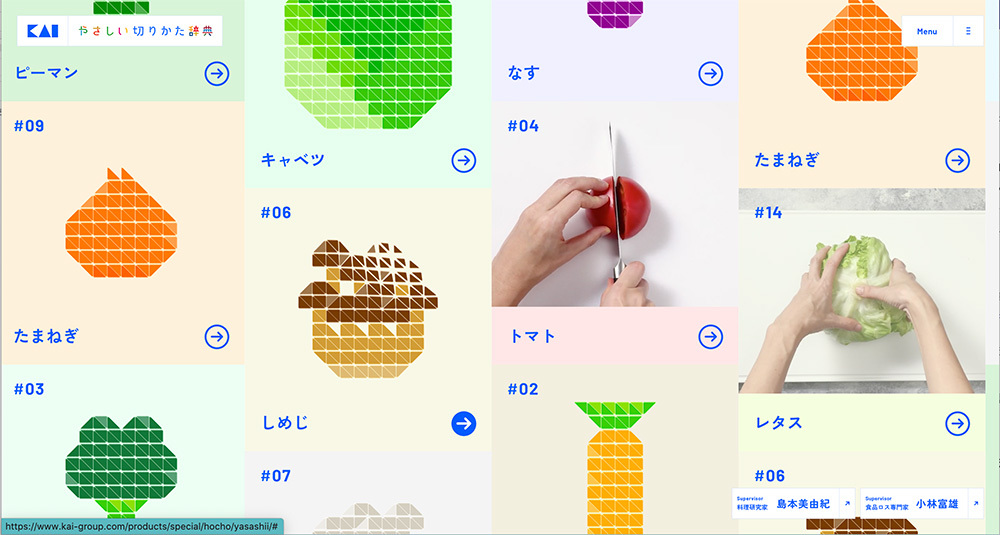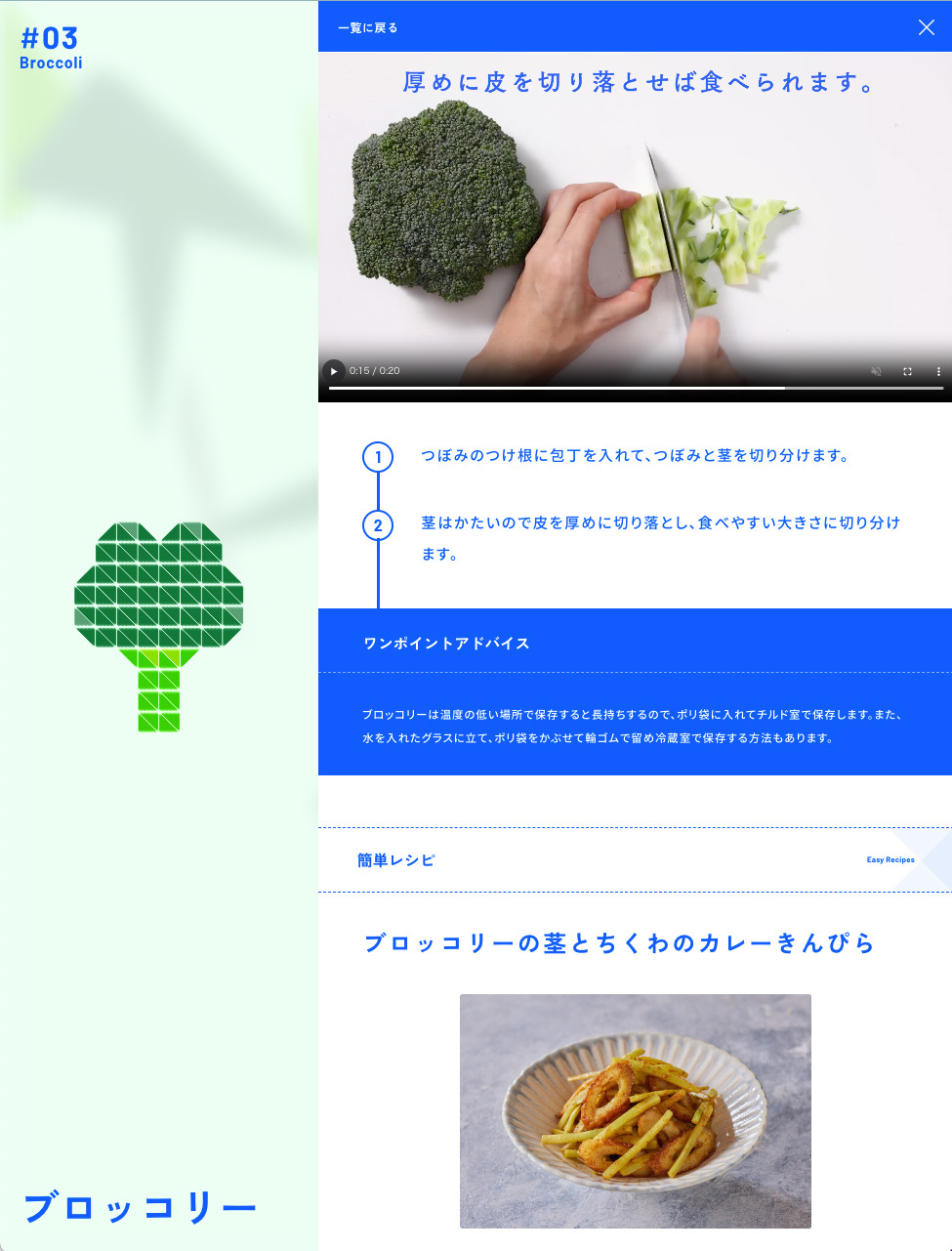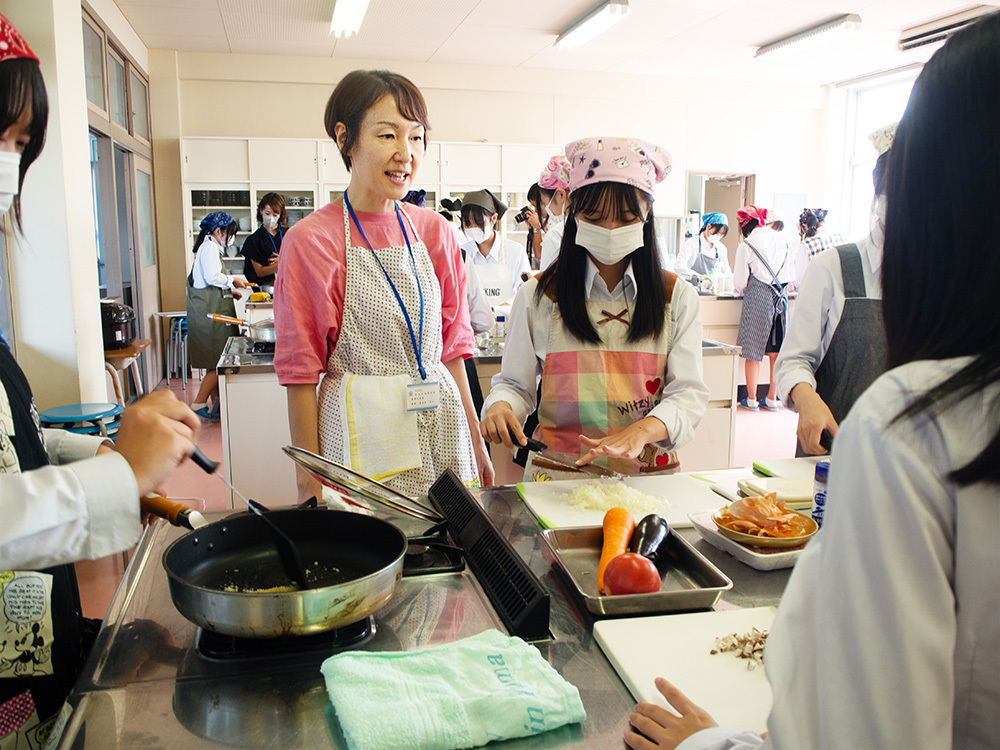Dentsu Inc.'s cross-functional creative organization, the Future Creative Center (FCC), is a group of over 80 members supporting the creation of the future through creativity, extending beyond the realm of advertising. In this series, centered on the theme "Future × Creativity," FCC members discuss their future initiatives.
While awareness of food loss is growing, one overlooked issue is the "excessive removal" of edible parts from ingredients. Excessive removal refers to cutting away and discarding parts that are actually edible. It is estimated(*) that this excessive removal contributes to approximately 338,000 tons of food loss discarded annually from households nationwide. However, compared to leftovers or outright waste, people rarely consciously recognize excessive removal as an issue.
To address this issue, knife manufacturer Kai Corporation launched the website "Gentle Cutting Dictionary." It introduces methods for cutting various vegetables without waste and features original recipes. The site debuted on August 31, 2022, "Vegetable Day." It won a Bronze Award in the ACC Design category and a consumer-selected advertising contest, earning praise as a uniquely "corporate" initiative befitting a knife manufacturer.
The site's key focus, precisely because it addresses a social issue, was to avoid delivering top-down messages like "This is how it should be done." Instead, it prioritized creating a user interface (UI) that visitors could genuinely enjoy. Behind this approach lay the philosophy of the KAI Corporation and Dentsu Inc. production team.
Project members—planner Yoshifumi Sato (Dentsu Inc. FCC), art director Sakura Yamaguchi, and business producer Sakurako Yasuda—reflect on the project's journey.
Other production team members: Copywriter Hitomi Shimazaki, Planner Hayashi Morita
It began with the idea that "knife manufacturers would be well-positioned to communicate about excessive trimming."
Sato: The background to this project was that while food loss due to over-trimming is significant, public awareness of this issue isn't necessarily high. Even in our surveys, while over 80% of respondents were aware of food loss, only 18.3% specifically identified over-trimming as a cause. This contrasts sharply with direct disposal (44.7%) and leftovers (36.7%).
Therefore, we launched the "Gentle Cutting Dictionary" website, which introduces methods for cutting vegetables without waste and provides recipes. Furthermore, we continue our activities today, including initiatives centered on the theme of "gentle cutting," such as collaborating with schools, companies, and local governments.
The initial project stemmed from Yamaguchi's proposal. Originally, Yasuda and I had been involved with Kai Corporation through their "#Shave with Freedom" campaign. Knowing this, Yamaguchi approached us saying, "I want to propose this idea to Kai Corporation."

Yamaguchi: Working in the food industry, I learned about the problem of excessive waste removal. I realized there's also the idea of being environmentally friendly through how we cut ingredients and use knives. When considering the clearest way to communicate this, I thought having a knife manufacturer share it would be best.
Kai Corporation already had a foundation for sending positive messages to society, starting with "#Shave with Freedom." So I approached Mr. Sato with the idea.
Sato: I thought it was an excellent idea. As later noted by the judges at the ACC Awards, it was crucial that Kai Corporation—with its long history of knife manufacturing—addressed the social issue of food waste through an approach that was uniquely suited to the company: "cutting vegetables without waste."
Yasuda: When we actually presented this idea to the Kaishin team, they were very receptive. The problem of over-trimming is something that can be solved starting today, without needing special tools or preparation. That's precisely why they agreed to take immediate action. They even said, "We want to release a statement specifically addressing the issue of over-trimming first."
Yamaguchi: However, KAI strongly requested avoiding a preachy tone. Our initial proposal materials emphasized a strong sense of "righteousness," framing the knife as a tool for global environmental action. In contrast, KAI stated from the start that while benefiting the planet is important, they didn't want to push that social significance. Instead, they wanted to focus on personal benefits – how reducing over-cutting makes the user happier and more satisfied.
Yasuda: I believe this aligns with Kai's long-held corporate stance of "no one is excluded." The expression "#ShaveFreedom" symbolized this, and this time too, rather than criticizing anyone by saying "over-trimming is bad," they wanted initiatives that support everyone in enjoying cooking without over-trimming.
Sato: Recently, there's been an increase in SDGs-related initiatives, and some people are experiencing "SDGs fatigue." Keeping that in mind, we proceeded with production aiming for something enjoyable for visitors, not preachy.
This serves as a reminder to myself: while initiatives addressing social issues often tempt us to make grand statements, starting with everyday, relatable actions is crucial. Furthermore, I believe this project only became possible because of the driving force and passion of the people at Kai Corporation. In that sense too, I think it turned out to be a great project.
The thought process of each creator, from the initial vegetable designs to their expression in tiles
Sato: When prioritizing enjoyment, we were particularly focused on the site's UI. More people are familiar with games these days, and users' UI literacy has improved. Even with initiatives addressing social issues, if the fun factor is weak or the site feels even slightly sluggish, users tend to leave instantly. It's not that UI doesn't matter because the theme is social issues; rather, precisely because it's about social issues, the UI is crucial. We aimed for a site that feels genuinely pleasant as a pure experience.
Specifically, we designed it so that when you scroll the screen, vegetable designs move or suddenly dance up, making it enjoyable just to interact with. We also paid attention to details in the site structure: while most sites start with an overview text, we designed it so visitors can start experiencing things immediately upon scrolling. We even implemented infinite scrolling, among other thoughtful touches.
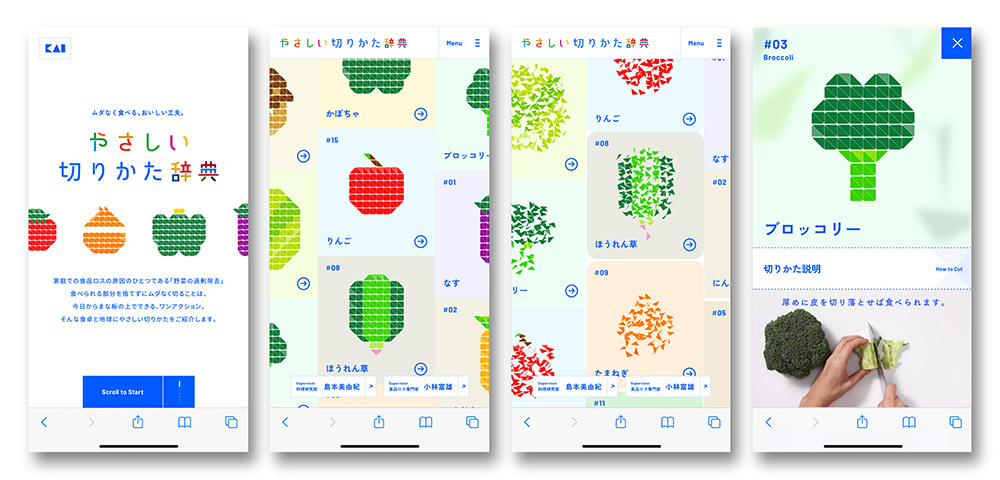
Yamaguchi: The most challenging part of the design was deciding how to express vegetables on this site and choosing the motif. Kai Corporation is a cutlery manufacturer, not a cooking company. We felt that making the vegetable expressions too homely might not be quite right.
Originally, the company had a well-organized, consistent branding strategy. Many of their initiatives incorporated sharp designs, and while looking at those, I thought objectively about how KAI would present itself if it handled food. Since the theme this time was cutting, the idea emerged to combine triangular tile-like shapes to create vegetable icons.
Sato: For the website production, we had Mr. Shiiki from Kome Inc., who excels in craft and digital creative, serve as producer. Under his direction and with the optimal team, we created high-quality expressions.
Yamaguchi: We initially requested "vegetable tiles to appear as if they're dancing," but they elevated it beyond that, making every detail of the motion enjoyable. The fact that the idea leaped forward by the time it was implemented was significant.
Yasuda: For the site's title and copy, as mentioned earlier, we pursued expressions that weren't condescending and that no one could object to. We conveyed that reducing excess waste is not only kind to the planet but also kind to household budgets, embedding the message that it's something you can personally enjoy. We refined the copy repeatedly right up to the end, brainstorming ideas with copywriter Shimazaki.
The campaign continues: We want to spread the word about "gentle cutting" through industry-government-academia collaboration
Yamaguchi: While the site itself launched in August 2022, this project has continued since then. We've collaborated with high schools, universities, local governments, and others on initiatives.
For example, Ikoma City in Nara Prefecture expressed interest in this content, leading to a special class called the "Gentle Cutting Method Workshop" at Nara Kita High School in the city. Driven by a desire to raise students' awareness about food loss and environmental considerations, Miyuki Shimamoto, the culinary researcher who supervised this website, served as the instructor. She taught methods for cutting vegetables with minimal waste and then guided the students in actually preparing dishes.
Sato: We hope to expand these classes to schools nationwide. Eventually, it would be great to see "Gentle Cutting Techniques" incorporated into home economics curricula. We plan to work with Kai Corporation to develop software that many schools can use in their classes.
Yasuda: Beyond this, at Japan Women's University's campus festival, volunteer students from the Food Science Department presented recipes utilizing the concepts of excess removal and "gentle cutting techniques." Additionally, KAI held a "Gentle Cutting Techniques Class in the Field" for elementary school children during summer vacation, based on the "Gentle Cutting Techniques Dictionary." This event combines vegetable harvesting in the field with learning about SDGs, including excess removal.
Sato: Our activities will continue, and we are actively seeking partners to collaborate with us. We would be delighted if interested parties—schools, companies, local governments, or others—would reach out to us.
Yamaguchi: Another issue related to food loss is misunderstanding best-before dates. These dates indicate when food is at its peak flavor, not that it becomes inedible afterward. To convey this true meaning, the government has run campaigns promoting the nickname "deliciousness guide."
Similarly, we want to widely spread the idea that simply changing how you cut food—based on the concept of "gentle cutting"—can be kinder to both the planet and yourself.
Website: Gentle Cutting Dictionary



